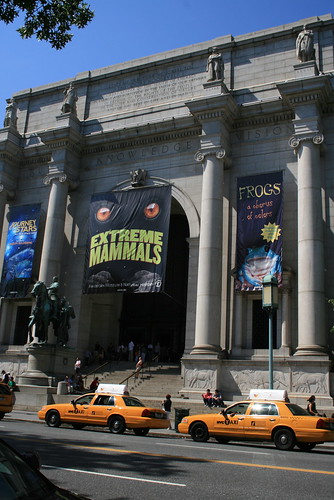
Our solution was to be selective, and to pick and choose the bits we really wanted to see. The African mammals were top of my list, with a big family of elephants taking centre stage in the hall, with the other exhibits lining the walls in their glass cases. Thankfully this was no Night At The Museum with them all coming to life again and running rampage!
The various bird displays from around the world were also interesting. However the European birds exhibit was quite 'tame' and boring compared to the eagles and hawks and penguins etc from the other continents and climates.
As well as animals and birds, a major part of the Natural History remit takes in peoples and their cultures. There were displays on home and family life, native clothing, food and diet, but the most interesting was the material on the religious life of the various cultures.
What was immediately obvious was that every culture had some sort of god or divine being, and had developed stories, rituals and images or idols relating to their understanding of the supernatural and death. There were no atheist societies featured!
But while each culture and people had some concept of the divine, each of their stories was very different. One south American culture had an elaborate story of the passage to paradise in the afterlife, whereby the soul had to cross a slippery tree bridge over a river, then avoid eye contact with two villages who would try to draw the soul to remain with them for eternity. After several other hazards, the soul would eventually reach the village of paradise and meet up with loved ones.
There was also a feature on the cult of ancestor worship in China, with shrines set up to forebears, who are still regarded as part of the family, even as much as a living relative would be. A great amount of display space was given to the various branches of Hindu, Sikh, Islamic and other eastern religions. Colourful representations of what the divine being was like were shown, with idols, images, and shrines.
If we were left to ourselves, given the very variety of the range of religions, we wouldn't know where to turn. Which is the right one? How can we know what God is truly like?
What is clear is that when we turn aside from the living God, humans seek to fill the God-shaped hole with all manner of contrivances and myths. Very religious, but not according to the truth.
For although they knew God, they did not honour him as God or give thanks to him, but they became futile in their thinking, and their foolish hearts were darkened. Claiming to be wise, they became fools, and exchanged the glory of the immortal God for images resembling mortal man and birds and animals and creeping things. (Romans 1:21-23)
So how can we know what God is truly like?
Thankfully we don't have to worry, or invent God, or fret. We can never know God by ourselves or our imagining, but God has graciously revealed himself, through his word delivered by the prophets, and now in these last days by his Son, the Lord Jesus Christ. There are not many deities and many gods, but one God, who reigns over all in the glory of his Trinity, Father, Son and Holy Spirit.
No comments:
Post a Comment